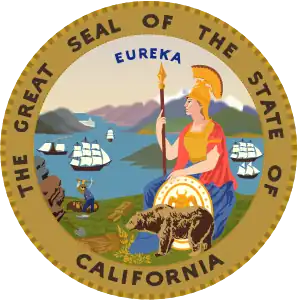Tapia Adobe
Tapia Adobe was the home of Tiburcio Tapia (1789–1845). Tiburcio Tapia was a Mexican soldier, politician, then became a merchant, winery owner and ranch owner, in what is now Cucamonga, California. The place of Tapia Adobe (home) was designated a California Historic Landmark (No.360) on October 9, 1939. Tiburcio Tapía received the land to build his Adobe and Rancho Cucamonga from a 1839 13,045-acre (52.79 km2) Mexican land grant in present-day San Bernardino County, California The land grant was from Mexican governor Juan Bautista Alvarado.[1] The grant formed parts of present-day Rancho Cucamonga and Upland. It extended easterly from San Antonio Creek to what is now Hermosa Avenue, and from today's Eighth Street to the mountains.[2][3][4]
| Tapia Adobe | |
|---|---|
.jpg.webp) Tapia Adobe Marker Sign | |
| Location | 8916 Foothill Blvd, Cucamonga, California |
| Coordinates | 34°06′26″N 117°36′39″W |
| Area | 13,045-acre (52.79 km2) |
| Built | 1839 |
| Architect | Tiburcio Tapia |
| Architectural style(s) | Adobe bricks |
| Designated | October 9, 1939. |
| Reference no. | 360 |
 Location of Tapia Adobe in California | |
.jpg.webp)
Rancho Cucamonga
Tiburcio Tapía started a winery the first in California and the second oldest in the United States. Tapía heirs sold Rancho de Cucamonga in 1858, and the large Adobe home was abandoned. The original home was built with sun-dried adobe bricks. Without a good roof adobe structures can be damaged quickly. With a good roof adobe structures still need constant maintenance. Tapia Adobe return to the earth. John Rains purchased Rancho Cucamonga. John Rains with his wife built in 1860, a new home and called it Casa de Rancho Cucamonga. Casa de Rancho Cucamonga was restored and is now a National Register of Historic Places.[5]Isaias W. Hellman, a Los Angeles banker, and a San Francisco business syndicate acquired the 13,045 acres (52.79 km2) Rancho Cucamonga at a sheriff's sale in 1871.[6] Hellman and his partners, which included former Governor John Downey, subdivided the land. Hellman continued to make port and sweet Angelica wine from Cucamonga's fabled vineyard. Tapia had first planted grapes in 1839 and Rains had increased the vineyard to 150 acres (0.61 km2) in 1859. Train service started in the area in 1887. Later the land was subdivided into the towns of Cucamonga, Etiwanda, and Alta Loma. The city of Rancho Cucamonga incorporate in 1977 from the three towns.[7] The northern part of Chaffey's Ontario colony became the city of Upland, incorporated in 1906.[8]
Tapia family
- Felipe Santiago Tapia (1745–1811), soldier in the de Anza Expedition.[9][10] Tapia Drive in San Francisco's Parkmerced is named for him. The nearby Cardenas Avenue is named for his wife.[11]
- Jose Bartolome Tapia (1766–1824), son of Felipe Santiago Tapia, eldest of nine children, grantee of Rancho Topanga Malibu Sequit.
- Tiburcio Tapia (1789–1845), son of Jose Bartolome Tapia, grantee of Rancho Cucamonga, Mayor of Los Angeles 1830, 1839 and 1840. Married María Tomasa Valdéz.
- Maria Merced Tapia de Prudhomme, daughter of Tiburcio Tapia, married Leon Victor Prudhomme.
Markers
Marker at the Tapia Adobe reads:
- In 1839 Governor Juan Alvarado granted the 13,000-acre tract called Cucamonga to Tiburcio Tapia, an ex-soldier who was a prominent merchant and alcalde in Los Angeles. A half-mile west of this marker Tapia, employing Indian laborers, immediately built an adobe house on a vantage point on Red Hill. The large adobe was abandoned in 1858 when Tapia's heirs sold the rancho. The adobe soon disintegrated into its native earth. This marker is located on land which once was a part of Tapia's rancho.[12]
Marker at Cucamonga Winery site reads:
- Established by Tiburcio Tapia, to whom the Cucamonga Rancho was granted March 3, 1839, by Governor Juan Bautista Alvarado of Mexico.[13]
See also
References
- Ogden Hoffman, 1862, Reports of Land Cases Determined in the United States District Court for the Northern District of California, Numa Hubert, San Francisco
- Diseño del Rancho Cucamonga
- "ArcGIS Web Application". sbcounty.maps.arcgis.com. San Bernardino County, California. Retrieved 2018-10-23. (see city boundaries vs. 8th/Hermosa north to mountains and west to San Antonio Creek)
- californiahistoricallandmarks.com 360
- sbcounty.gov, Casa de Rancho Cucamonga, John Rains House
- Hoover, Mildred B.; Rensch, Hero; Rensch, Ethel; Abeloe, William N. (1966). Historic Spots in California. Stanford University Press. ISBN 978-0-8047-4482-9.
- "History of Upland, CA". Retrieved 30 March 2013.
- "History of Ontario, CA". Retrieved 31 March 2013.
- Anza Expedition Roll Call Archived February 17, 2012, at the Wayback Machine
- Soldiers Of The De Anza 1775 Expedition Archived August 24, 2013, at the Wayback Machine
- The Chronicle 12 April 1987 p.7
- Maker Data Base Tapia Adobe
- californiahistoricallandmarks.com CHL No. 490
